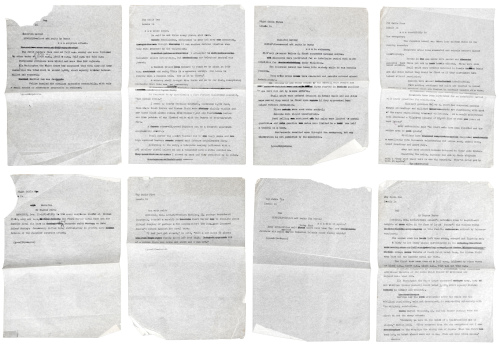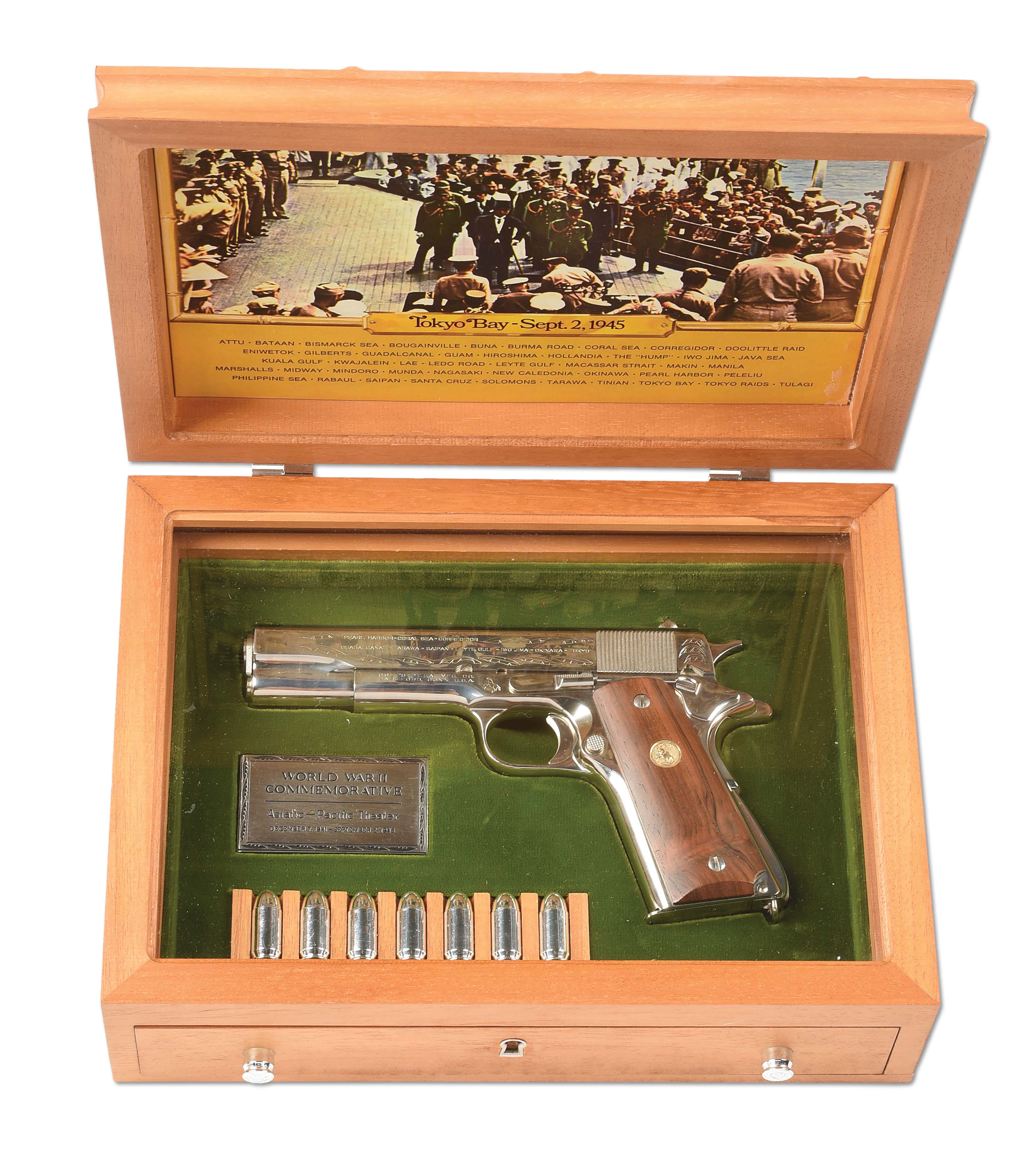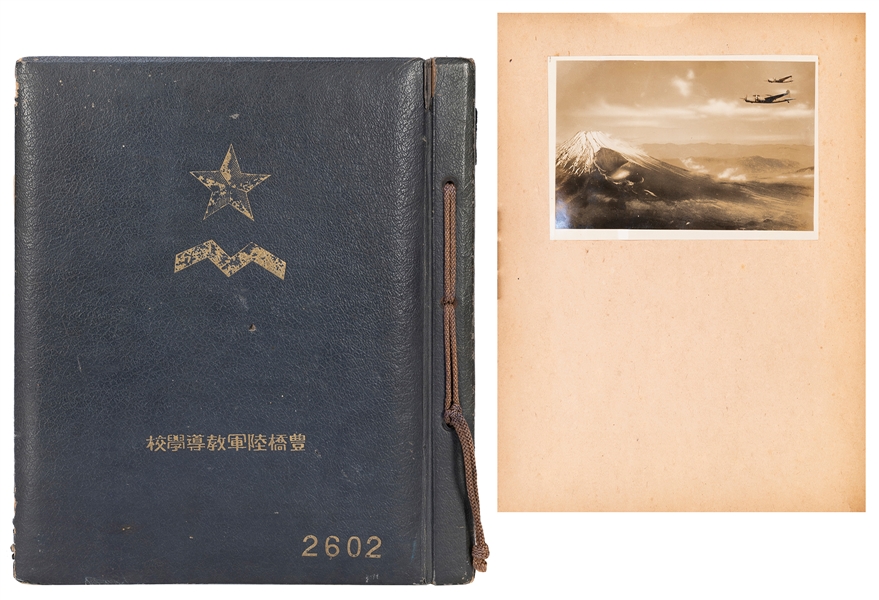WORLD WAR II]. PEARL HARBOR. Post-battle damage assessment map of Pearl Harbor. Titled in Japanese with English translation: "Estimated Damage Report against Surface Ships on the Air Attack of Pearl Harbor," December 8, 1941," PREPARED BY MITSUO FUCHIDA, LEAD PILOT OF THE JAPANESE ATTACK, FOR A BRIEFING OF EMPEROR HIROHITO, ON 26 DECEMBER 1941.
WORLD WAR II]. PEARL HARBOR. Post-battle damage assessment map of Pearl Harbor. Titled in Japanese with English translation: "Estimated Damage Report against Surface Ships on the Air Attack of Pearl Harbor," December 8, 1941," PREPARED BY MITSUO FUCHIDA, LEAD PILOT OF THE JAPANESE ATTACK, FOR A BRIEFING OF EMPEROR HIROHITO, ON 26 DECEMBER 1941. Large 2 o (31¾ x 23 5/8 in.; 807 x 602mm.), neatly creased, a clean marginal tear repaired. Black ink and watercolor pigments (red, green, blue, yellow and lavender). With Fucida's neat English captions in red ink. In very bright, fresh condition. TORA! TORA! TORA! A DETAILED MAP OF THE PEARL HARBOR ATTACK, DECEMBER 7, 1941 This graphic, detailed, hand-drawn map of Pearl Harbor was prepared by Commander Mitsuo Fuchida,(1902-1976) based on action reports compiled aboard the aircraft carrier Akagi in the weeks following the devastating attack. Fuchida, a highly experienced pilot, was chosen to command the massive wave of Japanese carrier-based bombers, torpedo planes and Zero fighters which attacked the American Navy's Pacific Fleet on the morning of Sunday, December 7, 1941, a "day that will live in infamy." Fuchida, flying with the first wave attackers, was charged to give the radio signal "Tora! Tora! Tora!" to confirm to his commanders that complete surprise had been obtained. This map or a photographic enlargement of it was employed in Fuchida's briefing of the Emperor on December 26, 1941. As he recounts, "standing directly across from His Majesty, I unfolded the layout in front of him and, pointing with my finger at the relevant places on the battlefield diagram, gave a blow-by-blow description of our battle achievements against the enemy ships...." (Fuchida, p.109). In large characters, the map carries a bold warning: "Top Secret." Beneath it is a key recording the types of munitions used in the attack: 250k and 800k bombs and torpedoes. Another key shows the amount of danger inflicted: "minor," "moderate," "serious" and "sunk." Torpedo tracks are rendered in red; bomb impacts with crosses. The position of American vessels, even small craft, is carefully shown; nearly all are identified in Japanese and English captions, the latter in red ink. Fuchida has drawn billowing explosions and flames issuing from six vessels. Clearly depicted are the dozen or so capital ships moored at Ford's Island, including the battleships Pennsylvania , Arizona , Tennessee, Maryland , California , Oklahoma , West Virginia and Nevada . In the overwhelming surprise attack, the West Virginia, California and Arizona were sunk; badly damaged were the Pennsylvania, Tennessee , Nevada, Oklahoma and Maryland . The results of the meticulously planned attack depicted here were devastating: sunk or severely damaged were 21 warships, while 200 aircraft were mostly destroyed on the ground. The most painful blow, though, was the terrific loss of life: at least 2,400 Americans were killed and some 1,272 wounded. News of the attack had far-reaching effects: it profoundly shocked and galvanized the America citizenry under the slogan "Remember Pearl Harbor!" Japan's bold gamble "gave every American a personal stake in the titanic struggle which raged in Europe and Asia." It "gave the average American a cause he could understand and believe worth fighting for." In the view of Gordon W. Prange, the foremost historian of the event, "Pearl Harbor became the turning point of the world struggle" (Prange, p.738). References : Gordon W. Prange. At Dawn We Slept. The Untold Story of Pearl Harbor ; Mitsuo Fuchida, For That One Day. The Memoirs of Mitsuo Fucida, Commander of the Attack on Pearl Harbor , 2011. Gordon Prange's definitive account of the attack, At Dawn We Slept , contains a vivid account of Fuchida's presentation to the Emperor: "Shortly after 1000 on December 26 Fuchida stood face-to-face with the man to whom he had dedicated his life. Later he admitted that leading the Pearl Harbor attack was much easier tha
WORLD WAR II]. PEARL HARBOR. Post-battle damage assessment map of Pearl Harbor. Titled in Japanese with English translation: "Estimated Damage Report against Surface Ships on the Air Attack of Pearl Harbor," December 8, 1941," PREPARED BY MITSUO FUCHIDA, LEAD PILOT OF THE JAPANESE ATTACK, FOR A BRIEFING OF EMPEROR HIROHITO, ON 26 DECEMBER 1941.
WORLD WAR II]. PEARL HARBOR. Post-battle damage assessment map of Pearl Harbor. Titled in Japanese with English translation: "Estimated Damage Report against Surface Ships on the Air Attack of Pearl Harbor," December 8, 1941," PREPARED BY MITSUO FUCHIDA, LEAD PILOT OF THE JAPANESE ATTACK, FOR A BRIEFING OF EMPEROR HIROHITO, ON 26 DECEMBER 1941. Large 2 o (31¾ x 23 5/8 in.; 807 x 602mm.), neatly creased, a clean marginal tear repaired. Black ink and watercolor pigments (red, green, blue, yellow and lavender). With Fucida's neat English captions in red ink. In very bright, fresh condition. TORA! TORA! TORA! A DETAILED MAP OF THE PEARL HARBOR ATTACK, DECEMBER 7, 1941 This graphic, detailed, hand-drawn map of Pearl Harbor was prepared by Commander Mitsuo Fuchida,(1902-1976) based on action reports compiled aboard the aircraft carrier Akagi in the weeks following the devastating attack. Fuchida, a highly experienced pilot, was chosen to command the massive wave of Japanese carrier-based bombers, torpedo planes and Zero fighters which attacked the American Navy's Pacific Fleet on the morning of Sunday, December 7, 1941, a "day that will live in infamy." Fuchida, flying with the first wave attackers, was charged to give the radio signal "Tora! Tora! Tora!" to confirm to his commanders that complete surprise had been obtained. This map or a photographic enlargement of it was employed in Fuchida's briefing of the Emperor on December 26, 1941. As he recounts, "standing directly across from His Majesty, I unfolded the layout in front of him and, pointing with my finger at the relevant places on the battlefield diagram, gave a blow-by-blow description of our battle achievements against the enemy ships...." (Fuchida, p.109). In large characters, the map carries a bold warning: "Top Secret." Beneath it is a key recording the types of munitions used in the attack: 250k and 800k bombs and torpedoes. Another key shows the amount of danger inflicted: "minor," "moderate," "serious" and "sunk." Torpedo tracks are rendered in red; bomb impacts with crosses. The position of American vessels, even small craft, is carefully shown; nearly all are identified in Japanese and English captions, the latter in red ink. Fuchida has drawn billowing explosions and flames issuing from six vessels. Clearly depicted are the dozen or so capital ships moored at Ford's Island, including the battleships Pennsylvania , Arizona , Tennessee, Maryland , California , Oklahoma , West Virginia and Nevada . In the overwhelming surprise attack, the West Virginia, California and Arizona were sunk; badly damaged were the Pennsylvania, Tennessee , Nevada, Oklahoma and Maryland . The results of the meticulously planned attack depicted here were devastating: sunk or severely damaged were 21 warships, while 200 aircraft were mostly destroyed on the ground. The most painful blow, though, was the terrific loss of life: at least 2,400 Americans were killed and some 1,272 wounded. News of the attack had far-reaching effects: it profoundly shocked and galvanized the America citizenry under the slogan "Remember Pearl Harbor!" Japan's bold gamble "gave every American a personal stake in the titanic struggle which raged in Europe and Asia." It "gave the average American a cause he could understand and believe worth fighting for." In the view of Gordon W. Prange, the foremost historian of the event, "Pearl Harbor became the turning point of the world struggle" (Prange, p.738). References : Gordon W. Prange. At Dawn We Slept. The Untold Story of Pearl Harbor ; Mitsuo Fuchida, For That One Day. The Memoirs of Mitsuo Fucida, Commander of the Attack on Pearl Harbor , 2011. Gordon Prange's definitive account of the attack, At Dawn We Slept , contains a vivid account of Fuchida's presentation to the Emperor: "Shortly after 1000 on December 26 Fuchida stood face-to-face with the man to whom he had dedicated his life. Later he admitted that leading the Pearl Harbor attack was much easier tha















Try LotSearch and its premium features for 7 days - without any costs!
Be notified automatically about new items in upcoming auctions.
Create an alert